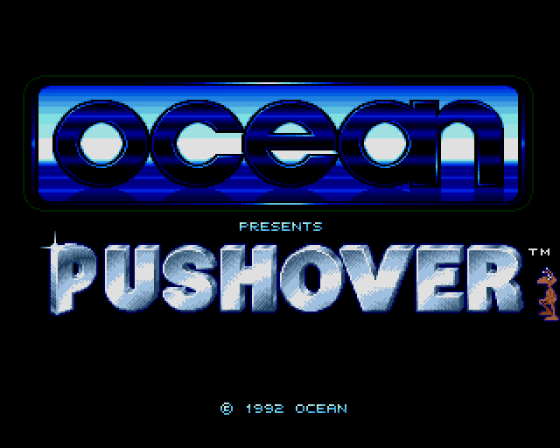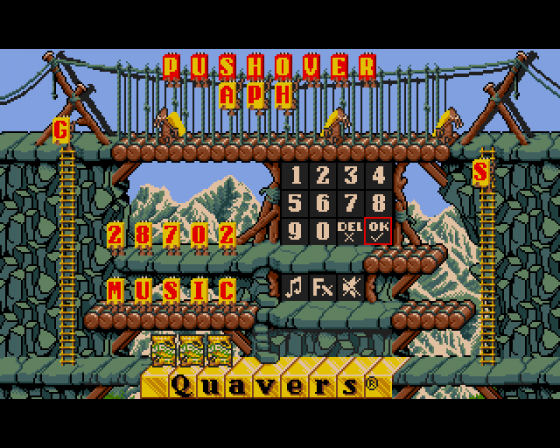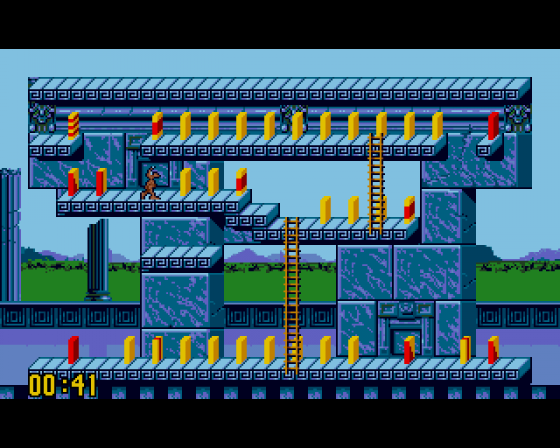
Amiga Power
 1st June 1992
1st June 1992
Categories: Review: Software
Author: Mark Ramshaw
Publisher: Ocean
Machine: Amiga 500
Published in Amiga Power #14
Pushover
Ocean's first original puzzler in years is this odd platform/dominoes mongrel. But is it ant-astic?
An Ocean game without a high profile established months before release? Without a six month build-up of stylish advertising? Without umpteen work-in-progress features? In other words, an old-fashioned, honest-to-goodness, hype-free original game? Well, no, not quite.
You see, Pushover may have been a bit hush-hush up until now, but a tie-in with Quavers (you know, the crisp things promoted by a bulldog called Colin with the voice of Lenny Henry) resulting in a half-million pound TV ad spend is certain to change all that. (Well, it worked for Mario and Walkers crisps.)
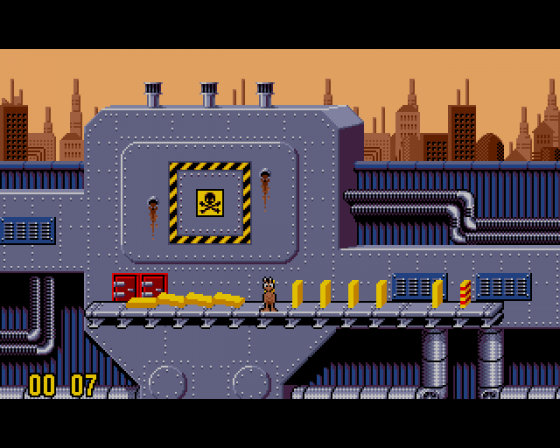
Oh great, you could be forgiven for thinking at this point, another of those half-baked cartoon game things, but this time featuring the dubious delights of Curly Colin, and maybe some digitised speech from our Lenny. Well, no actually - the TV hero only really enters into it during the intro sequence and on the occasional animated rest screens which offer the brain a bit of R&R. (The Quaver packs themselves have a slightly higher profile, actually appearing in the game themselves. Well, occasionally.)
No, the real hero of Pushover - the character the player controls - is, in fact, an ant (an escapee from Ocean's new Sim game, presumably), whose task it is to help Colin help his missing Quavers. And if he seems to have next-to-nothing to do with the famous curly snacks, wait until you see the basic game itself - a sort of arcade puzzle game featuring platforms, ladders and lots of toppling blocks. Imagine Lemmings crossed with dominoes and you won't be far out - the more you look at the game, the more obvious it becomes that Ocean had this scheduled for release anyway, and the Quavers connection is very much an (admittedly welcome) last minute add-on. Still, if it gets the game on TV...
Domino Dancing
If I was the kind of reviewer who want on to explain exactly how the game works at this point, I'd tell you something like this. For a start, I'd let you know that the screens are littered with various types of domino, which, when pushed by another domino, react in assorted different ways. And I'd tell you that your task in the game is to topple all the dominoes on the screen by moving them about the place a biit (your ant can carry one domino at a time) and then knocking them all over in one go, against a time limit of course.
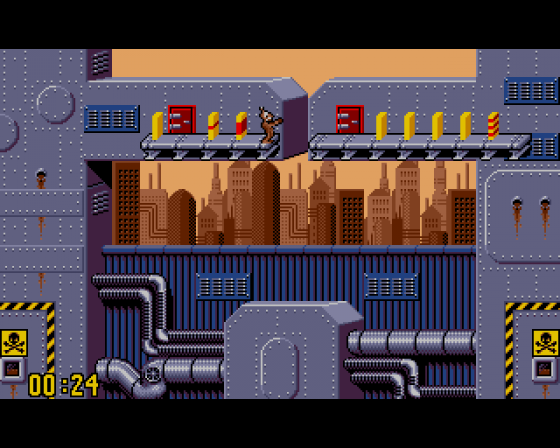
And since, of course, I am that kind of reviewer, I'll also go on to say that otherwise impossible-looking screens are in fact do-able only because some dominoes actually defy gravity (when hit, they will rise until they back into the underside of a platform above), while others will explode, leaving a hole in the platform on which they stand. Others split into two dominoes, some simply disappear while one type continues rotating along the platform, instead of simply toppling over. Thankfully a chart of the various domino types can be called up at any time to remind you of what they all are.
All clear? No? Then let me talk you quickly through a sample screen. The objective, you see, is to knock over the target, or 'trigger' domino (one with three horizontal stripes - so called because it triggers the exit) you see somewhere on the screen - and within a time limit. The fact that this must be the last domino hit (and no other may be still moving or left standing) and that, unlike the other doms, the target domino can't be moved about the screen at all, adds extra complications to an already complex game.
Completing the screen in the specified time (it varies between screens - the final one gives a ten minute countdown!) results in the player being awarded a token. These tokens can then be used to advance a level when you find one too tricky. Completing a screen outside of the time limit means either repeating the exercise or using a token to get any further.
Domino Theory

What we've got, then, is a game which relies on cause and effect. As only one domino push is allowed per screen, the bulk of the game sees you chasing around the platform and ladder networks, attempting to guess how each domino's fall will affect the next one, and shifting them about to get them to fall as you intend. All that's left to do, then, is select a domino to set the chain reaction in motion, hope for the best, and run for the exit. (Or that's true most of the time - in reality, some screens complicate things further by making you move some dominoes after the chain reaction has been intiated. Speed then becomes paramount.)
Of course, most of us are too thick to work out how each screen will work in our heads all the time - in reality, play often throws pre-planning out of the window, replacing it with hunches, guesswork, and blind trial-and-error/suck-it-and-see tactics. After a few frustrating screens, the concept of Chaos theory seems that much more familiar...
Quavering Heights
Decision time then - is it a hit (hurrah!) or a miss (boo!)? First let me make the obvious comment - yes, Pushover does look a bit like Lemmings, though as you pla it the comparison soon retreats from your mind. No, if it really resembles something from Psygnosis, it's their yet-to-be-released Tomato Game. The idea of building up a stream of objects then setting the ball in motion (as it were) is almost identical. (Of course the execution differs greatly between the games, but the resemblance is there.)
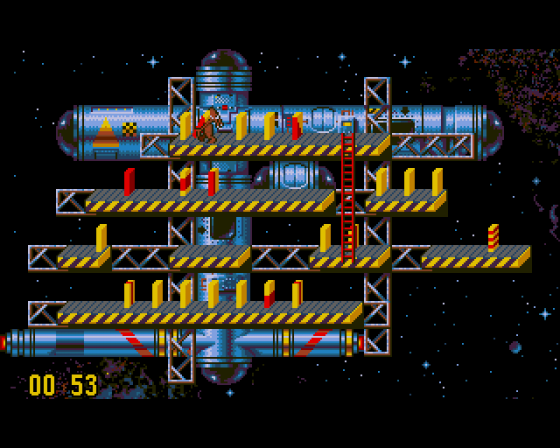
That comparison firmly squashed, then, what else can we say about it? Well, I must admit my first reaction to Pushover was something along the lines of 'Oh, is that it?' - it didn't look like anything to write home about. A few more plays brought things to the level of 'Mmm, this game's got something'. Then there was the period of 'Pity about the dull graphics and tenuous (and slightly desperate) tie-in'. Finally I achieved oneness with it, at which point I attained the level of 'Hey, this is a pretty groovy little puzzler after all'.
Well, alright, it's not exactly a state of nirvana, is it? But then, I don't think Pushover is the sort of game which is capable of doing that. Sure, it's fun. And yeah, it's damned addictive. But Pushover is not a Lemmings, a Populous, or a Monkey Island. It's not an event, a landmark game, a humbling experience. It's just quite groovy, in its own modest way.
The Bottom Line
Uppers: A strangely absorbing game style, which initially appears contrived and dumb, but soon becomes an obsession. One hundred levels and some variation in scenery should ensure lasting interest. A simple, straightforward control system too.
Downers: The animation of the ant, while packed with character, is still distinctly dodgy in some areas. The colours look a bit flat, and the attempt at graphic stylisation just doesn't really work.
A very tenuous tie-in, which is nonetheless a fine puzzle game. Nothing classic, and it could have been presented better (though the intro is neat), but fine nonetheless.

